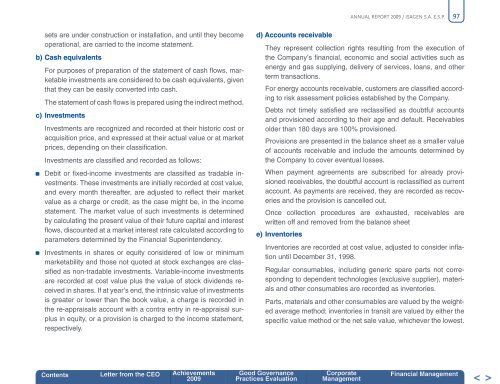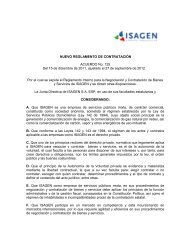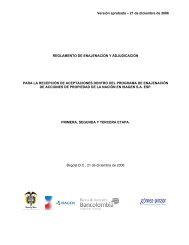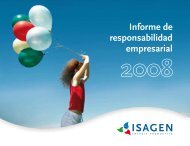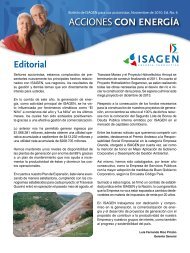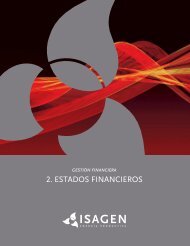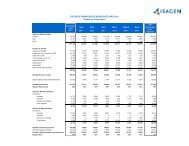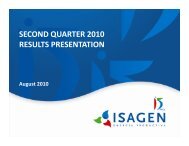Annual Report 2009 - Isagen
Annual Report 2009 - Isagen
Annual Report 2009 - Isagen
You also want an ePaper? Increase the reach of your titles
YUMPU automatically turns print PDFs into web optimized ePapers that Google loves.
ANNUAL REPORT <strong>2009</strong> / ISAGEN S.A. E.S.P.97sets are under construction or installation, and until they becomeoperational, are carried to the income statement.b) Cash equivalentsFor purposes of preparation of the statement of cash flows, marketableinvestments are considered to be cash equivalents, giventhat they can be easily converted into cash.The statement of cash flows is prepared using the indirect method.c) InvestmentsInvestments are recognized and recorded at their historic cost oracquisition price, and expressed at their actual value or at marketprices, depending on their classification.Investments are classified and recorded as follows:Debit or fixed-income investments are classified as tradable investments.These investments are initially recorded at cost value,and every month thereafter, are adjusted to reflect their marketvalue as a charge or credit, as the case might be, in the incomestatement. The market value of such investments is determinedby calculating the present value of their future capital and interestflows, discounted at a market interest rate calculated according toparameters determined by the Financial Superintendency.Investments in shares or equity considered of low or minimummarketability and those not quoted at stock exchanges are classifiedas non-tradable investments. Variable-income investmentsare recorded at cost value plus the value of stock dividends receivedin shares. If at year’s end, the intrinsic value of investmentsis greater or lower than the book value, a charge is recorded inthe re-appraisals account with a contra entry in re-appraisal surplusin equity, or a provision is charged to the income statement,respectively.d) Accounts receivableThey represent collection rights resulting from the execution ofthe Company’s financial, economic and social activities such asenergy and gas supplying, delivery of services, loans, and otherterm transactions.For energy accounts receivable, customers are classified accordingto risk assessment policies established by the Company.Debts not timely satisfied are reclassified as doubtful accountsand provisioned according to their age and default. Receivablesolder than 180 days are 100% provisioned.Provisions are presented in the balance sheet as a smaller valueof accounts receivable and include the amounts determined bythe Company to cover eventual losses.When payment agreements are subscribed for already provisionedreceivables, the doubtful account is reclassified as currentaccount. As payments are received, they are recorded as recoveriesand the provision is cancelled out.Once collection procedures are exhausted, receivables arewritten off and removed from the balance sheete) InventoriesInventories are recorded at cost value, adjusted to consider inflationuntil December 31, 1998.Regular consumables, including generic spare parts not correspondingto dependent technologies (exclusive supplier), materialsand other consumables are recorded as inventories.Parts, materials and other consumables are valued by the weightedaverage method; inventories in transit are valued by either thespecific value method or the net sale value, whichever the lowest.Contents Letter from the CEO Achievements<strong>2009</strong>Good GovernancePractices EvaluationCorporateManagementFinancial Management


